Effect of Outside Lights Projection Angle for Basketball Court Lighting
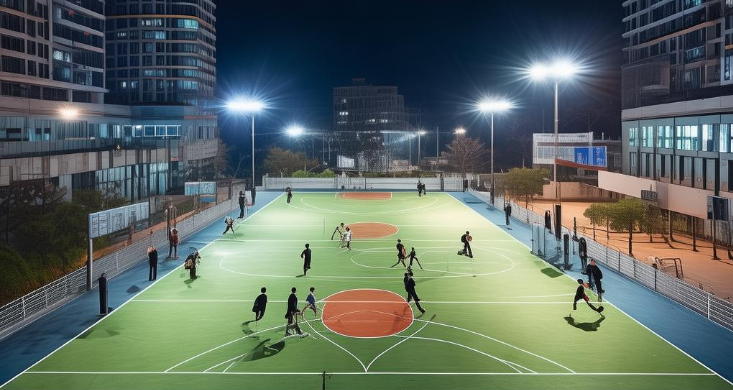
Directory:
1. Measurement of Illuminance at the Outside Basketball Court
2. Lighting Design and Simulation
The lighting in sports venues should not only fulfill spatial illumination needs but also increasingly consider people's subjective experiences, such as comfort. For venues hosting sports events that are TV broadcasted, it is essential to cater to the needs of athletes, spectators, and the lighting requirements of cameras. Therefore, a professional optical design tailored to various specifications is necessary for these sports venues.
Currently, most basketball courts typically utilize high-powered halogen or metal halide lamps, with installation configurations including four-tower setups, double-side arrangements, light strip layouts, and mixed arrangements. However, many of these configurations primarily focus on meeting illumination standards and achieving uniformity, often overlooking the subjective experiences of individuals. In sports, particularly basketball, when athletes are shooting or performing actions that require them to look up, they may directly face the light source. High-intensity lights can cause glare, which can significantly affect athletes, impairing their performance and potentially harming their health.
To address these issues, we conducted a lighting optimization design for an outside basketball court, using its existing lamps and fixtures. Given that the lamps are asymmetrical, the horizontal deflection angle and vertical pitch angle of the lamp installation significantly influence the lighting outcomes, necessitating different installation requirements compared to traditional lamps.
1. Measurement of Illuminance at the Outside Basketball Court
We performed field measurements of illuminance on the newly installed lights at an outside basketball training court. The court is of standard dimensions. Test points were chosen at distances of 2 meters between the long sides and 1.5 meters between the short sides, with a measurement height of 2 meters. Illuminance was recorded at each point without any interference from stray light. The findings are presented in Table 1.
Table 1 The test results of the outside basketball court horizontal illuminance lx
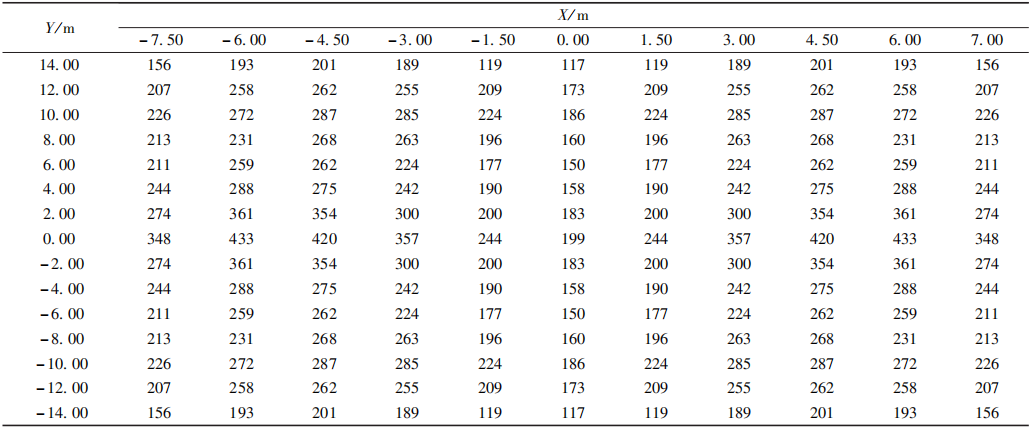
Data analysis reveals that the average horizontal illuminance of the court is 240 lx, with an illuminance uniformity of 0.49. Although a glare test was not performed, significant glare was still experienced at the measurement location. While the average illuminance of 240 lx is sufficient for this outside basketball court, which serves as a general training facility, the uniformity of 0.49 falls short of the required standards. Additionally, the incorrect projection angle of the lights often directs the light-emitting surface towards the eyes, causing discomfort. To provide a clearer view of the venue's uniformity, Figure 1 presents a three-dimensional distribution diagram of the horizontal illuminance measurements.
Fig1 3D distribution of the outside basketball court horizontal illuminance
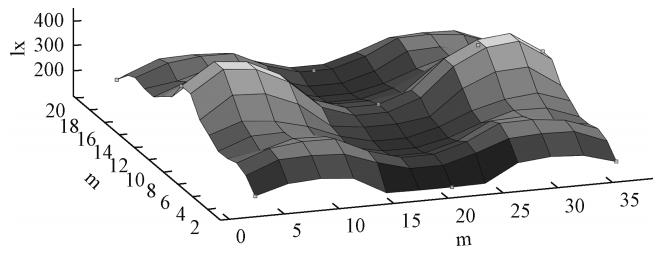
As illustrated in Figure 1. the illuminance below the middle lamp pole varies significantly, which impacts uniformity. When compared to the national standards for outside basketball court lighting uniformity, and considering the data presented in Table 1. it is evident that while the average horizontal illuminance meets the necessary criteria for amateur basketball courts, the uniformity of the illuminance is inadequate. There is a considerable disparity in brightness across the venue, with high illuminance directly under the lamp and lower levels at the edges, resulting in noticeable bright and dark spots. This variation can lead to rapid changes in light intensity during play, increasing glare and causing discomfort for athletes. The pupils may rapidly constrict and dilate, leading to visual fatigue, while glare can induce dizziness. Additionally, the high reflectivity of the outside basketball court surface combined with excessive lighting can create strong reflections. These factors can hinder athletes' performance, especially during actions like shooting and jumping, where intense light may directly impact their vision. In conclusion, to address the issues with the installed basketball court lighting, adjusting the installation angle could enhance uniformity and minimize glare.
2. Lighting Design and Simulation
2.1 Site Lighting Simulation
The location is equipped with LED flood light. which boasts a light efficiency exceeding 100 lm/W and a color rendering index above 80. The LED lamp has a power output of 120 W with an asymmetric light distribution, as illustrated in Figure 2. This asymmetric output effectively fulfills the lighting design criteria. To optimize resource utilization, the existing lamps and supporting structures will remain unchanged; only the installation angle and other specific details of the lamps will be adjusted.
Fig2 Light distribution
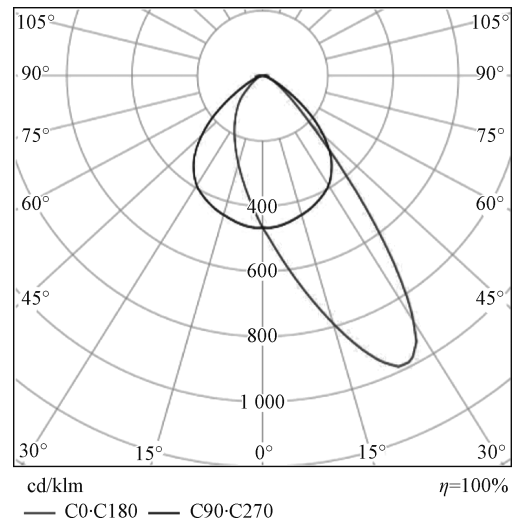
The DIAlux lighting design software is utilized to simulate the lighting conditions of the outside basketball court by adjusting the angle of the lamp projections. A model of the space is created using data collected from the site, with the scene depicted in Figure 3 (a). The venue features lighting installed on both sides, with three lamp poles on one side spaced 12 meters apart and standing 8 meters tall. The middle pole is equipped with three lamps, while the other two poles each have two lamps, resulting in a total of 14 lamps. Figure 3 (b) presents a top view of the lighting layout for the field.
Fig3 Lamp distribution
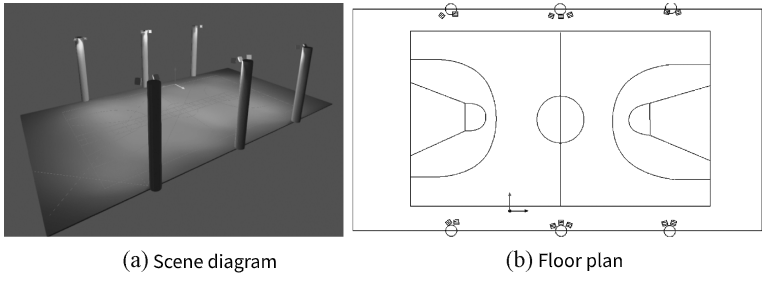
The lamp poles in this outside basketball court stand at a height of 8 meters and are spaced 12 meters apart, which are fixed measurements. The only adjustable factor is the lamp's projection angle. In the DIAlux software, this angle is set by manipulating the lamp's illumination point, typically the furthest point from the lamp to the calculation surface, although special designs may be necessary in certain situations. The lamp discussed in this article emits light asymmetrically. To achieve optimal results, the illumination point is adjusted multiple times during simulation calculations, taking into account the light's deflection angle. While the basketball court is the primary area for lighting, the edges of the court also require attention.
2.2 Lighting Simulation
As illustrated in Figure 2. the lamp's asymmetric light angle is approximately 30°. To determine the optimal projection direction, several auxiliary lines with a vertical deviation of 30° are drawn on the court, along with grid lines in the center for reference to aid in pinpointing the irradiation point. The placement of the irradiation point is a critical aspect of lighting design. Based on the symmetrical arrangement of lamps on either side of the venue and the 30° polarization angle, we first ensure even illumination along the symmetrical midline of the court, with all irradiation points located on this midline. Next, due to the venue's symmetry, the area is divided into four sections, and adjustments are made to the irradiation points in one quarter to achieve uniform lighting. Finally, using the established irradiation points from this quarter and the grid and auxiliary lines, the irradiation points for the entire venue are determined. Special attention is given to the unique areas at the venue's edges, where the lamp irradiation points are fine-tuned. Throughout this process, the asymmetric light output characteristics of the lamps are carefully considered. After several adjustments, a satisfactory set of irradiation point data is achieved, as shown in Figure 4.
The lamp's light distribution curve is then imported into the DIALux software, and the lamp parameters are set accordingly. Using the irradiation points from Figure 4. the illumination of the outside basketball court is simulated, with the results presented in Figure 5.
Fig4 Illuminating points of lamps
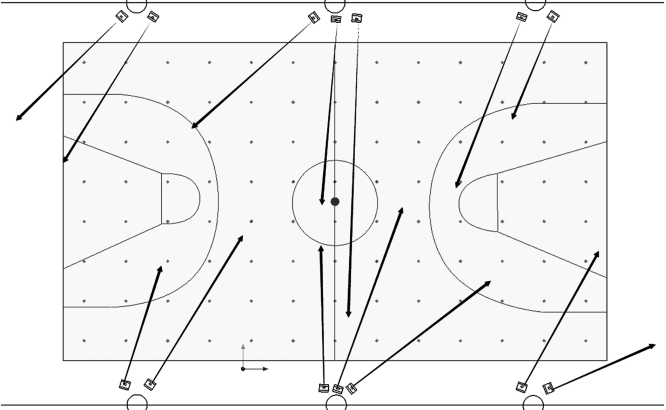
Fig5 The illuminance of the simulation place
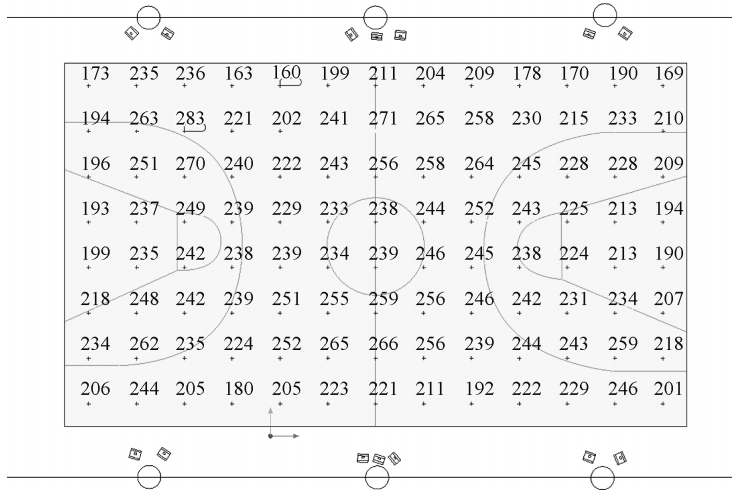
Examine the illumination data presented in Figure 5. which indicates that the average illumination level is 229 lx, with a uniformity rating of 0.7 and a uniform glare value below 10. After modifying the lamp's projection angle, the uniformity improved from a measured 0.49 to 0.7. and glare was also minimized. In the three-dimensional scene, it is noted that the lamp does not directly shine on the area. Consequently, following the adjustment of the lamp's angle, during basketball activities on the court, individuals will generally not be facing the light-emitting surface, thereby lessening glare effects.
The illumination three-dimensional diagram after the angle adjustment is depicted in Figure 6. In comparison to Figure 1. the illumination in Figure 6 shows no significant fluctuations, with a marked enhancement in uniformity and a reduction in glare.
Fig6 The 3D distribution of the simulation illuminance
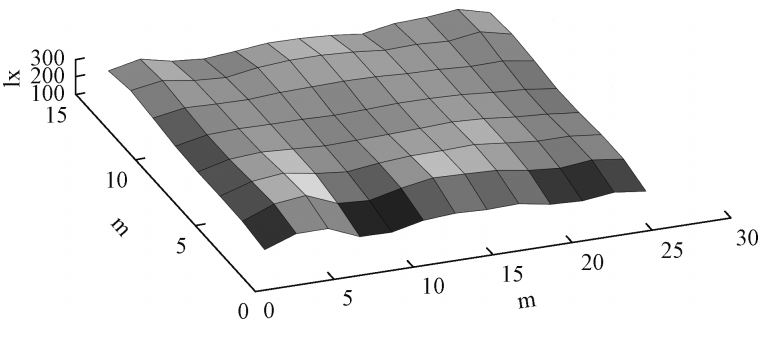
We assessed the horizontal illumination of an outside basketball court, finding an average illumination of 240 lx and a uniformity of 0.49. with noticeable glare present. When the lighting could only be modified by changing the lamp's projection angle, we utilized DIALux software to adjust the illumination points on the site to determine the optimal projection angle for each lamp. By applying these optimal angles, we simulated the horizontal illumination and achieved a uniformity of 0.7 and a glare value of less than 10. This optimization strategy effectively utilized the asymmetric light output characteristics of the existing lamps and identified suitable projection angles by adjusting the illumination points. In the simulated environment, there were no instances of the human eye being directed towards the light source. Consequently, adjusting the projection angle enhanced illumination uniformity and minimized glare, which is a crucial factor in lighting design.
3. Related Product
Outside basketball court light A01
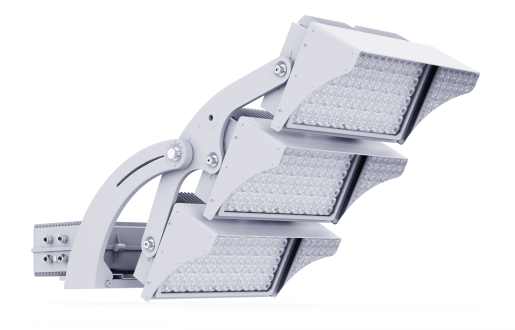
4. Related Blog
Outdoor Basketball Sport Court Lighting Control System Design
led outdoor basketball court lighting
Outdoor Basketball Court Lighting System Design